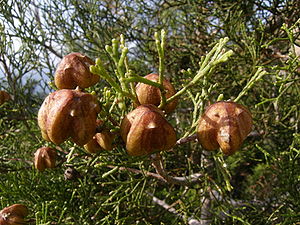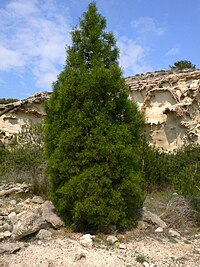Difference between revisions of "Tetraclinis articulata"
(New page: __NOTOC__{{Plantbox | name = ''LATINNAME'' <!--- replace LATINNAME with the actual latin name --> | common_names = <!--- if multiple, list all, if none, leave blank --> | growth_habi...) |
|||
| (3 intermediate revisions by 2 users not shown) | |||
| Line 1: | Line 1: | ||
| − | + | {{SPlantbox | |
| − | | | + | |familia=Cupressaceae |
| − | | | + | |genus=Tetraclinis |
| − | | | + | |species=articulata |
| − | | | + | |common_name=Alerce, Arar, Juniper gum plant |
| − | | | + | |Max ht box=50 |
| − | | | + | |Max ht metric=ft |
| − | | | + | |Max wd box=25 |
| − | | | + | |Max wd metric=ft |
| − | | exposure = | + | |exposure=sun |
| − | + | |features=bonsai | |
| − | | features = | + | |Temp Metric=°F |
| − | | | + | |min_zone=9 |
| − | | | + | |max_zone=11 |
| − | | | + | |image=Tetraclinis articulata8.jpg |
| − | + | |image_width=200 | |
| − | + | |image_caption=Tetraclinis articulata in the mountains of Cartagena, Spain | |
| − | | image = | ||
| − | | image_width = | ||
| − | | image_caption = | ||
| − | |||
| − | |||
| − | |||
| − | |||
| − | |||
| − | |||
| − | |||
| − | |||
| − | |||
}} | }} | ||
| + | [[File:Alhucemas (9).JPG|left|300px|thumb|Tetraclinis forest at [[Al Hoceima National Park]]]] | ||
| + | |||
| + | '''''Tetraclinis''''' is a [[genus]] of [[evergreen]] [[Pinophyta|coniferous]] [[tree]] in the [[Cupressaceae|cypress]] family [[Cupressaceae]], containing only one species, '''''Tetraclinis articulata''''', also known as '''Sandarac''' or the '''Barbary thuja'''<ref>http://books.google.com/books?id=fuwBN04nF9QC&pg=PA118&lpg=PA118&dq=barbary+thuja&source=bl&ots=8IHOTJDovW&sig=GA6vr4pZ2ehEYozmp8Pc2Xl9Yu0&hl=en&ei=CeWZSerfKJ6DtwfTl5CcCw&sa=X&oi=book_result&resnum=1&ct=result</ref>, [[endemism|endemic]] to the western [[Mediterranean region]]. It grows at relatively low altitudes in a hot, dry subtropical [[Mediterranean climate]].<ref name=farjon>Farjon, A. (2005). ''Monograph of Cupressaceae and Sciadopitys''. Royal Botanic Gardens, Kew. ISBN 1-84246-068-4</ref> | ||
| + | |||
| + | [[File:Alhucemas (11).JPG|left|300px|thumb|Tetraclinis cones at [[Al Hoceima National Park]]]] | ||
| + | |||
| + | It is a small, slow-growing tree, to 6–15 m (rarely 20 m) tall and 0.5 m (rarely 1 m) trunk diameter, often with two or more trunks from the base. The foliage forms in open sprays with scale-like [[leaf|leaves]] 1–8 mm long and 1–1.5 mm broad; the leaves are arranged in opposite decussate pairs, with the successive pairs closely then distantly spaced, so forming apparent whorls of four. The [[conifer cone|cones]] are 10–15 mm long, green ripening brown in about 8 months from pollination, and have four thick scales arranged in two opposite pairs. The [[seed]]s are 5–7 mm long and 2 mm broad, with a 3–4 mm broad papery wing on each side.<ref name=farjon/><ref name=rushforth>Rushforth, K. (1999). ''Trees of Britain and Europe''. Collins ISBN 0-00-220013-9.</ref> | ||
| + | |||
| + | It is one of only a small number of conifers able to [[coppice]] (re-grow by sprouting from stumps), an adaptation to survive [[wildfire]] and moderate levels of browsing by animals. Old trees that have sprouted repeatedly over a long period form large burrs at the base, known as ''lupias''.<ref name=farjon/> | ||
| + | |||
| + | The species has also been used in [[Bonsai]]. It is grown as an [[ornamental tree]], valued in hot, dry climates; it can be trimmed as a [[hedge (barrier)|hedge]].<ref name=rushforth/> | ||
| + | |||
{{Inc| | {{Inc| | ||
| − | + | Callitris quadrivalvis, Vent. (Thuja articulata, Vahl). Arab-tree. Sandarach. Gum Tree. Small tree, with fragrant hard durable wood: branches jointed and spreading: Ivs. very small, flattened, distichous, reduced to scales at the nodes: cone 4-sided, small, the valves oval and with a protuberance near the tip. N. Afr., in the mts. —Furnishes varnish resin (gum sandarach). | |
| − | Callitris quadrivalvis, Vent. (Thuja articulata, Vahl). Arab-tree. Sandarach. Gum Tree. Small tree, with fragrant hard durable wood: branches jointed and spreading: Ivs. very small, flattened, distichous, reduced to scales at the nodes: cone 4-sided, small, the valves oval and with a protuberance near the tip. N. Afr., in the mts | ||
{{SCH}} | {{SCH}} | ||
}} | }} | ||
| Line 51: | Line 50: | ||
<gallery> | <gallery> | ||
| + | Image:Araar-root-burl-cup.jpg|A cup made of root burr wood from the Essaouira area of Morocco | ||
| + | Image:Koeh-270.jpg|Illustration from Koehler's ''Medicinal-Plants'' (1887) | ||
Image:Upload.png| photo 1 | Image:Upload.png| photo 1 | ||
Image:Upload.png| photo 2 | Image:Upload.png| photo 2 | ||
| Line 66: | Line 67: | ||
{{stub}} | {{stub}} | ||
| − | + | __NOTOC__ | |
| − | |||
| − | |||
Latest revision as of 22:46, 20 April 2010
| Height: | ⇕ | 50 ft"ft" can not be assigned to a declared number type with value 50. |
|---|---|---|
| Width: | ⇔ | 25 ft"ft" can not be assigned to a declared number type with value 25. |
| Exposure: | ☼ | sun |
|---|---|---|
| Features: | ✓ | bonsai |
| USDA Zones: | 9 to 11 |

Tetraclinis is a genus of evergreen coniferous tree in the cypress family Cupressaceae, containing only one species, Tetraclinis articulata, also known as Sandarac or the Barbary thuja[1], endemic to the western Mediterranean region. It grows at relatively low altitudes in a hot, dry subtropical Mediterranean climate.[2]

It is a small, slow-growing tree, to 6–15 m (rarely 20 m) tall and 0.5 m (rarely 1 m) trunk diameter, often with two or more trunks from the base. The foliage forms in open sprays with scale-like leaves 1–8 mm long and 1–1.5 mm broad; the leaves are arranged in opposite decussate pairs, with the successive pairs closely then distantly spaced, so forming apparent whorls of four. The cones are 10–15 mm long, green ripening brown in about 8 months from pollination, and have four thick scales arranged in two opposite pairs. The seeds are 5–7 mm long and 2 mm broad, with a 3–4 mm broad papery wing on each side.[2][3]
It is one of only a small number of conifers able to coppice (re-grow by sprouting from stumps), an adaptation to survive wildfire and moderate levels of browsing by animals. Old trees that have sprouted repeatedly over a long period form large burrs at the base, known as lupias.[2]
The species has also been used in Bonsai. It is grown as an ornamental tree, valued in hot, dry climates; it can be trimmed as a hedge.[3]
Read about Tetraclinis articulata in the Standard Cyclopedia of Horticulture
|
|---|
|
Callitris quadrivalvis, Vent. (Thuja articulata, Vahl). Arab-tree. Sandarach. Gum Tree. Small tree, with fragrant hard durable wood: branches jointed and spreading: Ivs. very small, flattened, distichous, reduced to scales at the nodes: cone 4-sided, small, the valves oval and with a protuberance near the tip. N. Afr., in the mts. —Furnishes varnish resin (gum sandarach). CH
|
Cultivation
- Do you have cultivation info on this plant? Edit this section!
Propagation
- Do you have propagation info on this plant? Edit this section!
Pests and diseases
- Do you have pest and disease info on this plant? Edit this section!
Species
Gallery
If you have a photo of this plant, please upload it! Plus, there may be other photos available for you to add.
References
- Standard Cyclopedia of Horticulture, by L. H. Bailey, MacMillan Co., 1963
External links
- w:Tetraclinis articulata. Some of the material on this page may be from Wikipedia, under the Creative Commons license.
- Tetraclinis articulata QR Code (Size 50, 100, 200, 500)
- ↑ http://books.google.com/books?id=fuwBN04nF9QC&pg=PA118&lpg=PA118&dq=barbary+thuja&source=bl&ots=8IHOTJDovW&sig=GA6vr4pZ2ehEYozmp8Pc2Xl9Yu0&hl=en&ei=CeWZSerfKJ6DtwfTl5CcCw&sa=X&oi=book_result&resnum=1&ct=result
- ↑ 2.0 2.1 2.2 Farjon, A. (2005). Monograph of Cupressaceae and Sciadopitys. Royal Botanic Gardens, Kew. ISBN 1-84246-068-4
- ↑ 3.0 3.1 Rushforth, K. (1999). Trees of Britain and Europe. Collins ISBN 0-00-220013-9.



